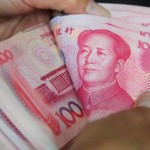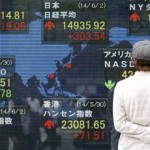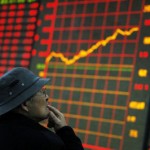China loosens monetary policy

China loosened monetary conditions last quarter at the fastest pace in almost two years, a Bloomberg LP gauge showed, testing the waning effectiveness of credit in supporting economic growth.
Bloomberg’s new China Monetary Conditions Index — a weighted average of loan growth, real interest rates and China’s real effective exchange rate — rose 6.71 points to 82.81 in the second quarter from the previous three months. That’s the biggest jump since the July-September period of 2012, with May and June’s numbers the first back-to-back readings above 80 since January 2012.
New yuan loans in July will be a record high for that month, according to a Bloomberg News survey of analysts before data due by Aug. 15, suggesting officials are keeping the credit spigot open even as debt risks mount. While consumer inflation below the government’s goal allows room for more easing, economic data will determine how far policy makers go.
“The central bank worries more about inflation and financial risks, but the government is worried more about growth and employment,” said Ding Shuang, senior China economist at Citigroup Inc. in Hong Kong. “Growth will rebound in the second half, so that will give the central bank some support in not expanding credit and liquidity further.”
With Premier Li Keqiang saying he wants financing charges cut for some sectors to support growth, “the central bank will still be under pressure, not necessarily to expand credit, but to lower lending costs,” Ding said.
Price Gains
Each $1 in new credit added the equivalent of an extra 20 cents in GDP in the first half of 2014, according to data compiled by Bloomberg. That compares with 29 cents in full-year 2012 and 2013 and 83 cents in 2007, when global money markets began to freeze.
Inflation figures released Aug. 9 suggest monetary easing has yet to trigger price gains in the broader economy. The consumer price index rose 2.3 percent in July from a year earlier, the same pace as in June and below the government’s 3.5 percent target. The producer price index fell 0.9 percent, the 29th straight decline.
Bloomberg’s monetary index was introduced in July, with the data series compiled back to 2003. The gauge peaked at 148.02 in November 2009 amid China’s 4 trillion-yuan stimulus plan during the global financial crisis.
“This index gives you a handy one-shot explanation of what China’s doing on its monetary policy and its relationship with growth,” said Fielding Chen, a Bloomberg economist in Hong Kong who created the gauge. “It’s showing us that the current pickup in growth momentum, which is likely to be a little stronger in the coming few months, is underpinned by accommodative monetary conditions.”
Targeted Measures
China’s monetary loosening in the second half may not be as strong as in the first half, while liquidity may remain “relatively loose,” according to a front-page commentary today in the state-run China Securities Journal.
Premier Li ordered targeted easing measures to help areas of the economy including agriculture, low-income housing and small businesses, following a first-quarter growth slowdown.
The PBOC on Aug. 8 announced a 12 billion yuan ($1.9 billion) quota for re-discounted loans to spur credit to small businesses and agriculture, building on previous moves to support the sectors. Its second-quarter monetary-policy report showed the average weighted interest rate of loans fell to 7.26 percent in June from 7.37 percent in March.
‘Fine Line’
“The government is generally trying to walk a fine line between loosening credit enough to get the economy going, but not to allow there to be another credit boom,” said Stephen Green, head of Greater China research at Standard Chartered Plc in Hong Kong. “But growth over the next two, three and four years is going to depend on reforms, so we need to get some of those feeding through.”
While economic expansion picked up to 7.5 percent in the April-June period from a year earlier, growth in the third and fourth quarters will dip back to 7.4 percent, according to median estimates in Bloomberg News surveys of analysts.
Data due Aug. 13 from the statistics bureau will provide more indications of the impact of Li’s easing. Industrial output growth in July kept pace with June’s 9.2 percent gain, which was the biggest for a single month since December, while growth in fixed-asset investment excluding rural households picked up to 17.4 percent in the first seven months, according to Bloomberg News surveys.
Broadest Measure
Central bank figures due by Aug. 15 will show new local-currency loans in July were 780 billion yuan, which would be a record high for that month. Aggregate financing, the PBOC’s broadest measure of credit, was probably 1.5 trillion yuan in July, 83 percent higher than a year earlier, a separate survey showed.
Total debt reached 251 percent of gross domestic product as of June, up from 234 percent in 2013 and 160 percent in 2008, according to Standard Chartered estimates. Bad loans at China’s commercial banks rose to 1.08 percent of total lending at the end of June, the highest in three years, government data show.
“The government set the growth target at 7.5 percent and they want to keep their promise, so they are prepared to keep policy accommodative even at the cost of rising leverage,” said Larry Hu, head of China economics at Macquarie Securities Ltd. in Hong Kong. “But they are very likely to lower the target next year — China just can’t grow at 7.5 percent without government stimulus and without adding leverage.”
Source: bloomberg





























